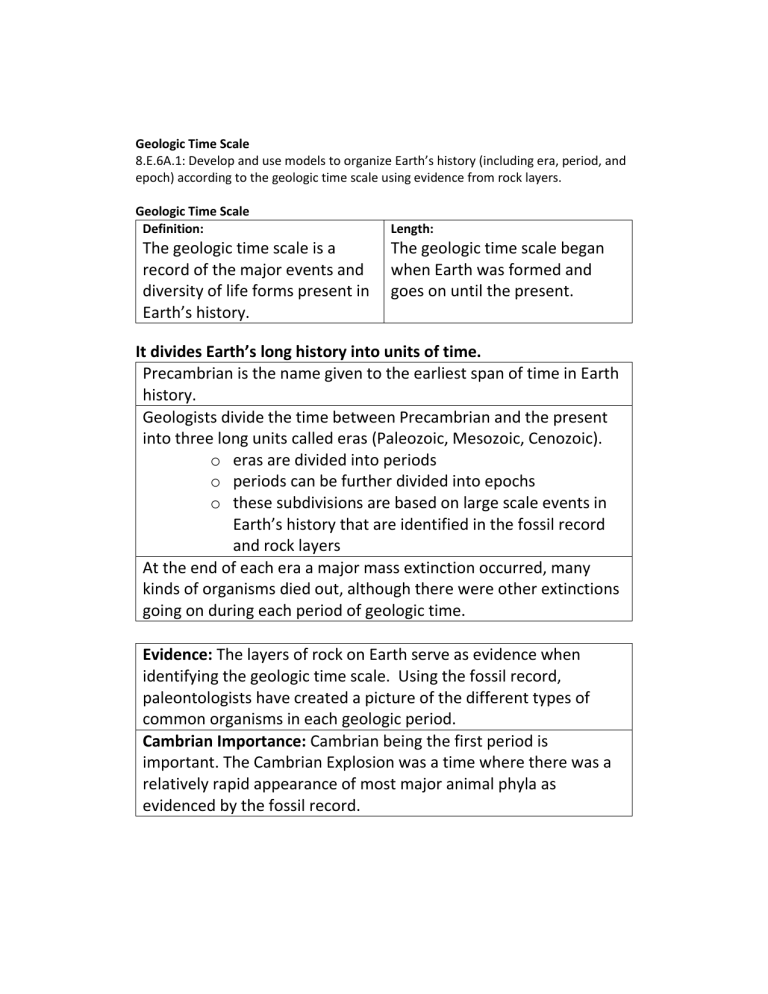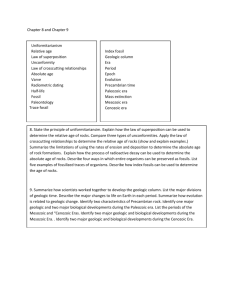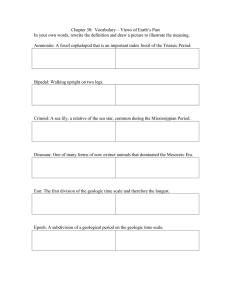
Geologic Time Scale 8.E.6A.1: Develop and use models to organize Earth’s history (including era, period, and epoch) according to the geologic time scale using evidence from rock layers. Geologic Time Scale Definition: The geologic time scale is a record of the major events and diversity of life forms present in Earth’s history. Length: The geologic time scale began when Earth was formed and goes on until the present. It divides Earth’s long history into units of time. Precambrian is the name given to the earliest span of time in Earth history. Geologists divide the time between Precambrian and the present into three long units called eras (Paleozoic, Mesozoic, Cenozoic). o eras are divided into periods o periods can be further divided into epochs o these subdivisions are based on large scale events in Earth’s history that are identified in the fossil record and rock layers At the end of each era a major mass extinction occurred, many kinds of organisms died out, although there were other extinctions going on during each period of geologic time. Evidence: The layers of rock on Earth serve as evidence when identifying the geologic time scale. Using the fossil record, paleontologists have created a picture of the different types of common organisms in each geologic period. Cambrian Importance: Cambrian being the first period is important. The Cambrian Explosion was a time where there was a relatively rapid appearance of most major animal phyla as evidenced by the fossil record. Paleozoic Era Began with the early invertebrates, such as trilobites and brachiopods; continued to develop early vertebrate fish, then arachnids and insects; later came the first amphibians, and near the era’s end the reptiles became dominant. Early land plants included simple mosses, ferns, and then cone-bearing plants. By the end of the era, seed plants were common. The mass extinction that ended the era caused most marine invertebrates as well as amphibians to disappear. A major geologic event of the Paleozoic was the formation of the super continent of Pangaea. Mesozoic Era Reptiles were the dominant animals of this era, including the various dinosaurs. Small mammals and birds also appeared. Toward the end of the era, flowering plants appeared and the kinds of mammals increased. The mass extinction that ended the era caused the dinosaurs to become extinct. A major geologic event of the Mesozoic was the break-up of the super continent of Pangaea into several large continents. Cenozoic Era New mammals appeared while others became extinct. The diversity of life forms increased. Flowering plants became most common. Humans are also part of the most recent period of this era. Present day Earth is in this era. A major geologic event of the Cenozoic is the further splitting and moving of continents to their current positions






